Forest Landscape Change and Preliminary Study on Its Driving Forces in Ślęża Landscape Park (Southwestern Poland) in 1883–2013
Abstract
1. Introduction
- What have the quantitative changes within the forest and non-forest landscapes over a period of 140 years, divided into three periods of time, covering approximately 40–50 years, been?
- In which time period was the landscape change index (LCI), which determines the level of change in landscapes, more intensive? Is it possible to calculate the index based on historical data?
- What have the main types of forest and non-forest landscape transformations been in the studied area?
- What are the characteristics of identified landscape changes in the context of natural factors such as elevation, slope, and hillside exposure as well as socioeconomic factors such as population changes, distances to built-up areas, main roads, and capitals of municipalities?
2. Materials and Methods
2.1. Case Study Area
2.2. Identification of Changes in Forest Landscapes
2.3. Driving Forces of Changes in Forest Landscapes
3. Results
3.1. Changes in Forest and Non-Forest Land Cover in the Years 1883–2013
3.2. Driving Forces of Changes in Forest Landscapes between 1883(89) and 2013
3.2.1. Natural Driving Forces of Landscape Change
3.2.2. Socioeconomic Driving Forces of Landscape Change
4. Discussion
5. Conclusions
Author Contributions
Funding
Acknowledgments
Conflicts of Interest
References
- Vitousek, P.M.; Mooney, H.A.; Lubchenco, J.; Melillo, J.M. Human Domination of Earth’s Ecosystems. Science 1997, 277, 494–499. [Google Scholar] [CrossRef]
- Antrop, M. Landscape change and the urbanization process in Europe. Landsc. Urban Plan. 2004, 67, 9–26. [Google Scholar] [CrossRef]
- Bičík, I.; Kupková, L.; Jeleček, L.; Kabrda, J.; Štych, P.; Janoušek, Z.; Winklerová, J. Land Use Changes in the Czech Republic 1845–2010: Socio-Economic Driving Forces. Springer: Basel, Switzerland, 2015; ISBN 978-3-319-17671-0. [Google Scholar]
- Łowicki, D. Land use changes in Poland during transformation: Case study of Wielkopolska region. Landsc. Urban Plan. 2008, 87, 279–288. [Google Scholar] [CrossRef]
- Skokanová, H.; Falťan, V.; Havlíček, M. Driving forces of main landscape change processes from past 200 years in Central Europe—differences between old democratic and post-socialist countries. Ekológia (Bratislava) 2016, 35, 50–65. [Google Scholar] [CrossRef]
- Heffner, K. Zmiany przestrzenne na obszarach wiejskich w Polsce w okresie transformacji i po wejściu do Unii Europejskiej. In Obszary wiejskie—wiejska przestrzeń i ludność, aktywność społeczna i przedsiębiorczość; Heffner, K., Klemens, B., Eds.; Studia KPZK PAN: Warsaw, Poland, 2016; pp. 12–27. [Google Scholar]
- Bičik, I.; Jeleček, L.; Štěpánek, V. Land-use changes and their social driving forces in Czechia in the 19th and 20th centuries. Land Use Policy 2001, 18, 65–73. [Google Scholar] [CrossRef]
- Peña, J.; Bonet, A.; Bellot, J.; Sánchez, J.R.; Eisenhuth, D.; Hallett, S.; Aledo, A. Driving forces of land-use change in a cultural landscape of Spain. In Modelling Land-use Change; Springer: Dordrecht, The Netherlands, 2007; pp. 97–116. ISBN 978-1-4020-6484-5. [Google Scholar]
- Liesovsky, J.; Bezak, P.; Spulerova, J.; Liesovsky, T.; Koleda, P.; Dobrovodska, M.; Bürgi, M.; Gimmi, U. The abandonment of traditional agricultural landscape in Slovakia—Analysis of extent and driving forces. J. Rural Stud. 2015, 37, 75–84. [Google Scholar] [CrossRef]
- Hersperger, A.M.; Bürgi, M. Driving forces of landscape change in the urbanizing Limmat Valley, Switzerland. In Modelling Land-Use Change; Springer: Dordrecht, The Netherlands, 2007; pp. 45–60. ISBN 978-1-4020-6484-5. [Google Scholar]
- Tokarczyk-Dorociak, K.; Kazak, J.; Szewrański, S. The Impact of a Large City on Land Use in Suburban Area—The Case of Wrocław (Poland). J. Ecol. Eng. 2018, 19, 89–98. [Google Scholar] [CrossRef]
- Zewdie, M.; Worku, H.; Bantider, A. Temporal Dynamics of the Driving Factors of Urban Landscape Change of Addis Ababa During the Past Three Decades. Environ. Manag. 2018, 61, 132–146. [Google Scholar] [CrossRef]
- Idczak, P.; Mrozik, K. Periurbanisation—Evidence from Polish metropolitan areas. Econ. Environ. Stud. 2018, 18, 183–202. [Google Scholar] [CrossRef]
- Przybyła, K.; Kulczyk-Dynowska, A. Transformations of Tourist Functions in Urban Areas of the Karkonosze Mountains. IOP Conf. Ser. Mater. Sci. Eng. 2017, 245, 072001. [Google Scholar] [CrossRef]
- Krajewski, P. Assessing changes in high-value landscape—Case study of the municipality of Sobotka in Poland. Polish J. Environ. Stud. 2017, 26, 2603–2610. [Google Scholar] [CrossRef]
- Saura, S.; Martín-Queller, E.; Hunter, M.L. Forest landscape change and biodiversity conservation. In Forest Landscapes and Global Change; Azevedo, J., Perera, A., Pinto, M., Eds.; Springer: New York, NY, USA, 2014; pp. 167–198. ISBN 978-1-4939-0953-7. [Google Scholar]
- Choi, J.; Lee, S.; Ji, S.Y.; Jeong, J.-C.; Lee, P.S.-H. Landscape Analysis to Assess the Impact of Development Projects on Forests. Sustainability 2016, 8, 1012. [Google Scholar] [CrossRef]
- Wu, Z.; Ge, Q.; Dai, E. Modeling the Relative Contributions of Land Use Change and Harvest to Forest Landscape Change in the Taihe County, China. Sustainability 2017, 9, 708. [Google Scholar] [CrossRef]
- Kruhlov, I.; Thom, D.; Chaskovskyy, O.; Keeton, W.S.; Scheller, R.M. Future forest landscapes of the Carpathians: Vegetation and carbon dynamics under climate change. Reg. Environ. Chang. 2018, 18, 1555–1567. [Google Scholar] [CrossRef]
- Mercuri, A.M.; Marignani, M.; Sadori, L. Palaeoecology and long-term human impact in plant biology, Plant Biosystems. Plant Biosyst. 2015, 149, 136–143. [Google Scholar] [CrossRef]
- Zanon, M.; Davis, B.A.S.; Marquer, L.; Brewer, S.; Kaplan, J.O. European Forest Cover During the Past 12,000 Years: A Palynological Reconstruction Based on Modern Analogs and Remote Sensing. Front. Plant Sci. 2018, 9, 253. [Google Scholar] [CrossRef] [PubMed]
- Antrop, M. Sustainable landscapes: contradiction, fiction or utopia? Landsc. Urban Plan. 2006, 75, 187–197. [Google Scholar] [CrossRef]
- Bürgi, M.; Hersperger, A.M.; Scheenberger, N. Driving forces of landscape change—Current and new directions. Landsc. Ecol. 2004, 19, 857–868. [Google Scholar] [CrossRef]
- Hersperger, A.M.; Bürgi, M. Going beyond landscape change description: Quantifying the importance of driving forces of landscape change in a Central Europe case study. Land Use Policy 2009, 26, 640–648. [Google Scholar] [CrossRef]
- Lin, X.; Wang, Y.; Wang, S.; Wang, D. Spatial differences and driving forces of land urbanization in China. J. Geogr. Sci. 2015, 25, 545–558. [Google Scholar] [CrossRef]
- Plieninger, T.; Bieling, C. (Eds.) Connecting cultural landscapes to resilience. In Resilience and the Cultural Landscape: Understanding and Managing Change in Human-shaped Environments; Cambridge University Press: New York, NY, USA, 2012; pp. 3–26. ISBN 978-1-107-02078-8. [Google Scholar]
- Mrozik, K.; Bossy, M.; Zaręba, K. Polityka przestrzenna gmin wiejskich na tle zmian zagospodarowania przestrzennego wynikających z suburbanizacji. Rocznik Ochrona Środowiska 2012, 14, 761–771. [Google Scholar]
- Solecka, I.; Raszka, B.; Krajewski, P. Landscape analysis for sustainable land use policy: A case study in the municipality of Popielów, Poland. Land Use Policy 2018, 75, 116–126. [Google Scholar] [CrossRef]
- Council of Europe. European Landscape Convention, Florence, 2000. ETS No. 176. Available online: http://conventions.coe.int/Treaty/en/Treaties/Html/176.htm. (accessed on 20 June 2018).
- Krajewski, P. Landscape change index as a tool for spatial analysis. J. IOP Mater. Sci. Engin. 2017, 245, 072014. [Google Scholar] [CrossRef]
- Kistowski, M. Wybrane Aspekty Zarządzania Ochroną Przyrody w Parkach Krajobrazowych; Uniwersytet Gdański: Gdańsk, Poland, 2004; ISBN 83-7326-188-5. [Google Scholar]
- Krajewski, P. Problemy planistyczne na terenach parków krajobrazowych w sąsiedztwie Wrocławia na przykładzie Ślężańskiego Parku Krajobrazowego. Res. Papers Wroclaw Univ. Econ. 2014, 367, 147–154. [Google Scholar] [CrossRef]
- Brandt, J.; Primdahl, J.; Reenberg, A. Rural land-use and dynamic forces—Analysis of ‘driving forces’ in space and time. In Land-use Changes and Their Environmental Impact in Rural Areas in Europe; Krönert, R., Baudry, J., Bowler, I.R., Reenberg, A., Eds.; UNESCO: Paris, France, 1999; pp. 81–102. ISBN 1-85070-047-8. [Google Scholar]
- Seabrook, L.; McAlpine, C.; Fensham, R. Cattle, crops and clearing: Regional drivers of landscape change in the Bridglow Belt, Queensland, Australia, 1840–2004. Landsc. Urban Plan. 2006, 78, 373–385. [Google Scholar] [CrossRef]
- Marucci, D. Landscape history as a planning tool. Landsc. Urban Plan. 2000, 49, 67–81. [Google Scholar] [CrossRef]
- Scheenberger, N.; Bürgi, M.; Hersperger, A.M.; Ewald, K.C. Driving forces and rates of landscape change as a promising combination for landscape change research—An application on the northern fringe of the Swiss Alps. Land Use Policy 2007, 24, 349–361. [Google Scholar] [CrossRef]
- Hersperger, A.M.; Gennaio, M.; Verburg, P.H.; Bürgi, M. Linking land change with driving forces and actors: Four conceptual models. Ecol. Soc. 2010, 15, 1–17. [Google Scholar] [CrossRef]
- Bürgi, M.; Straub, A.; Gimmi, U.; Salzmann, D. The recent landscape history of Limpach Valley, Switzerland: Considering three empirical hypotheses on driving forces of landscape change. Landsc. Ecol. 2010, 25, 287–297. [Google Scholar] [CrossRef]
- Bieling, C.; Plieninger, T.; Schaich, H. Patterns and causes of land change: Empirical results and conceptual considerations derived from a case study in the Swabian Alb, Germany. Land Use Policy 2013, 35, 192–203. [Google Scholar] [CrossRef]
- Lieskovský, J.; Kanka, R.; Bezák, P.; Štefunková, D.; Petrovič, F.; Dobrovodská, M. Driving forces behind vineyard abandonment in Slovakia following the move to a market-oriented economy. Land Use Policy 2013, 32, 356–365. [Google Scholar] [CrossRef]
- Krajewski, P. Landscape changes in selected suburban area of Bratislava (Slovakia). In Landscape and Landscape Ecology: Proceedings of the 17th International Symposium on Landscape Ecology; Halada, L., Baca, A., Boltizar, M., Eds.; Institute of Landscape Ecology, Slovak Academy of Sciences: Bratislava, Slovakia, 2016; pp. 110–117. ISBN 978-80-89325-28-3. [Google Scholar]
- Serra, P.; Pons, X.; Sauri, D. Land-cover and land-use change in a Mediterranean landscape: A spatial analysis of driving forces integrating biophysical and human factors. Appl. Geogr. 2008, 28, 189–209. [Google Scholar] [CrossRef]
- Geri, F.; Amici, V.; Rocchini, D. Human activity impact on the heterogeneity of Mediterranean landscape. Appl. Geogr. 2010, 30, 370–379. [Google Scholar] [CrossRef]
- Bürgi, M.; Bieling, C.; Von Hackwitz, K.; Kizos, T.; Liesovsky, J.; Martin, M.G.; McCarthy, S.; Müller, M.; Plieninger, T.; Printsmann, A. Processes and driving forces in changing cultural landscapes across Europe. Landsc. Ecol. 2017, 32, 2097–2112. [Google Scholar] [CrossRef]
- Szabo, P. Driving forces of stability and change in woodland structure: A case-study from the Czech lowlands. For. Ecol. Manag. 2010, 259, 650–656. [Google Scholar] [CrossRef]
- Loran, C.; Munteanu, C.; Verburg, P.H.; Schmatz, D.R.; Bürgi, M.; Zimmermann, N.E. Long-term change in drivers of forest cover expansion: An analysis for Switzerland (1850–2000). Reg. Environ. Chang. 2017, 17, 2223–2235. [Google Scholar] [CrossRef]
- Mwangi, H.M.; Lariu, P.; Julich, S.; Patil, S.D.; McDonald, M.A.; Feger, K.-H. Characterizing the Intensity and Dynamics of Land-Use Change in the Mara River Basin, East Africa. Forests 2018, 9, 8. [Google Scholar] [CrossRef]
- Frayer, J.; Müller, D.; Sun, Z.; Munroe, D.K.; Xu, J. Processes Underlying 50 Years of Local Forest-Cover Change in Yunnan, China. Forests 2014, 5, 3257–3273. [Google Scholar] [CrossRef]
- Plieninger, T.; Draux, H.; Fagerholm, N.; Bieling, C.; Bürgi, M.; Kizos, T.; Kuemmerle, T.; Primdahl, J.; Verburg, P.H. The driving forces of landscape change in Europe: A systematic review of the evidence. Land Use Policy 2016, 57, 204–214. [Google Scholar] [CrossRef]
- Regulation of the Lower Silesian Voivode dated 4 April 2007 regarding Ślęża Landscape Park. Available online: http://oi.uwoj.wroc.pl/dzienniki/Dzienniki_2007/Dz_U_Nr_94.pdf (accessed on 20 June 2018).
- Krajewski, P. Ślęża Landscape Park; Lower Silesian Association of Landscape Park: Wroclaw, Poland, 2012; ISBN 978-83-63166-03-8. [Google Scholar]
- Matuszkiewicz, W.; Faliński, J.B.; Kostrowicki, A.S.; Matuszkiewicz, J.M.; Olaczek, R.; Wojterski, T. Potential Natural Vegetation of Poland. General Map 1:300,000; IGiPZ PAN: Warszawa, Poland, 1995. [Google Scholar]
- Baude, M.; Meyer, B.C. Changes of landscape structure and soil production function since the 18th century in north-west Saxony. J. Environ. Geogr. 2012, 3, 11–23. [Google Scholar]
- Affek, A. Georeferencing of historical maps using GIS, as exemplified by the Austrian Military Surveys of Galicia. Geographia Pol. 2013, 86, 375–390. [Google Scholar] [CrossRef]
- Jaskulski, M.; Łukasiewicz, D.; Nalej, M. Comparison of methods for historical map transformation. Ann. Geomatics 2013, 11, 41–57. [Google Scholar]
- Szymura, T.H.; Murak, S.; Szymura, M.; Raduła, M.W. Changes in forest cover in Sudety Mountains during the last 250 years: Patterns, drivers, and landscape-scale implications for nature conservation. Acta Societatis Botanicorum Poloniae 2018, 87, 1–14. [Google Scholar] [CrossRef]
- Song, K.; Wang, Z.; Du, J.; Liu, L.; Zeng, L.; Ren, C. Wetland Degradation: Its Driving Forces and Environmental Impacts in the Sanjiang Plain, China. Environ. Manag. 2014, 54, 255–271. [Google Scholar] [CrossRef] [PubMed]
- Corona, R.; Galicia, L.; Palacio-Prieto, J.L.; Bürgi, M.; Hersperger, A.M. Local deforestation patterns and driving forces in a tropical dry forest in two municipalities of southern Oaxaca, Mexico (1985–2006). Investigaciones Geográficas 2016, 91, 86–104. [Google Scholar] [CrossRef]
- Sobala, M.; Rahmonov, O.; Myga-Piątek, U. Historical and contemporary forest ecosystem changes in the Beskid Mountains (southern Poland) between 1848 and 2014. iForest Biogeosci. For. 2017, 10, 939–947. [Google Scholar] [CrossRef]
- Szabó, P. Changes in woodland cover in the Carpathian Basin. In Human Nature: Studies in Historical Ecology and Environmental History; Szabó, P., Hédl, R., Eds.; Institute of Botany of the ASCR: Brno, Czech Republic, 2008; pp. 106–115. [Google Scholar]
- Plit, J. Analiza historyczna jako źródlo informacji o środowisku przyrodniczym. Problemy Ekologii Krajobrazu 2006, 16, 217–226. [Google Scholar]
- Szewrański, S.; Świąder, M.; Kazak, J.K.; Tokarczyk-Dorociak, K.; Van HooF, J. Socio-environmental vulnerability mapping for environmental and flood resilience assessment: The case of ageing and poverty in the city of Wroclaw, Poland. Integr. Environ. Assess. Manag. 2018, 14, 592–597. [Google Scholar] [CrossRef] [PubMed]
- Wulff, M.; Rujner, H. A GIS-based method for the reconstruction of the late eighteenth century forest vegetation in the Prignitz region (NE Germany). Landsc. Ecol. 2011, 26, 153–168. [Google Scholar] [CrossRef]
- Kozak, J. Forest cover change in the Western Carpathians in the past 180 years: A case study in the Orawa region in Poland. Mt. Res. Dev. 2003, 23, 369–375. [Google Scholar] [CrossRef]
- Munteanu, C.; Kuemmerle, T.; Boltiziar, M.; Butsic, V.; Gimmi, U.; Lúboš, H.; Kaim, D.; Király, G.; Konkoly-Gyuró, É.; Kozak, J.; et al. Forest and agricultural land change in the Carpathian region—A meta-analysis of long-term patterns and drivers of change. Land Use Policy 2014, 38, 685–697. [Google Scholar] [CrossRef]
- Nyrek, A. Kultura użytkowania gruntów uprawnych, lasów i wód na Śląsku od XV do XX wieku; Wydawnictwo Uniwersytetu Wrocławskiego: Wrocław, Poland, 1992. [Google Scholar]
- Staffa, M.; Mazurski, K.R.; Czerwiński, J.; Pisarski, G. Słownik geografii turystycznej Sudetów. Tom 20. Masyw Ślęży, Równina Świdnicka, Kotlina Dzierżoniowska; Wydawnictwo I-Bis: Wrocław, Poland, 2005. [Google Scholar]
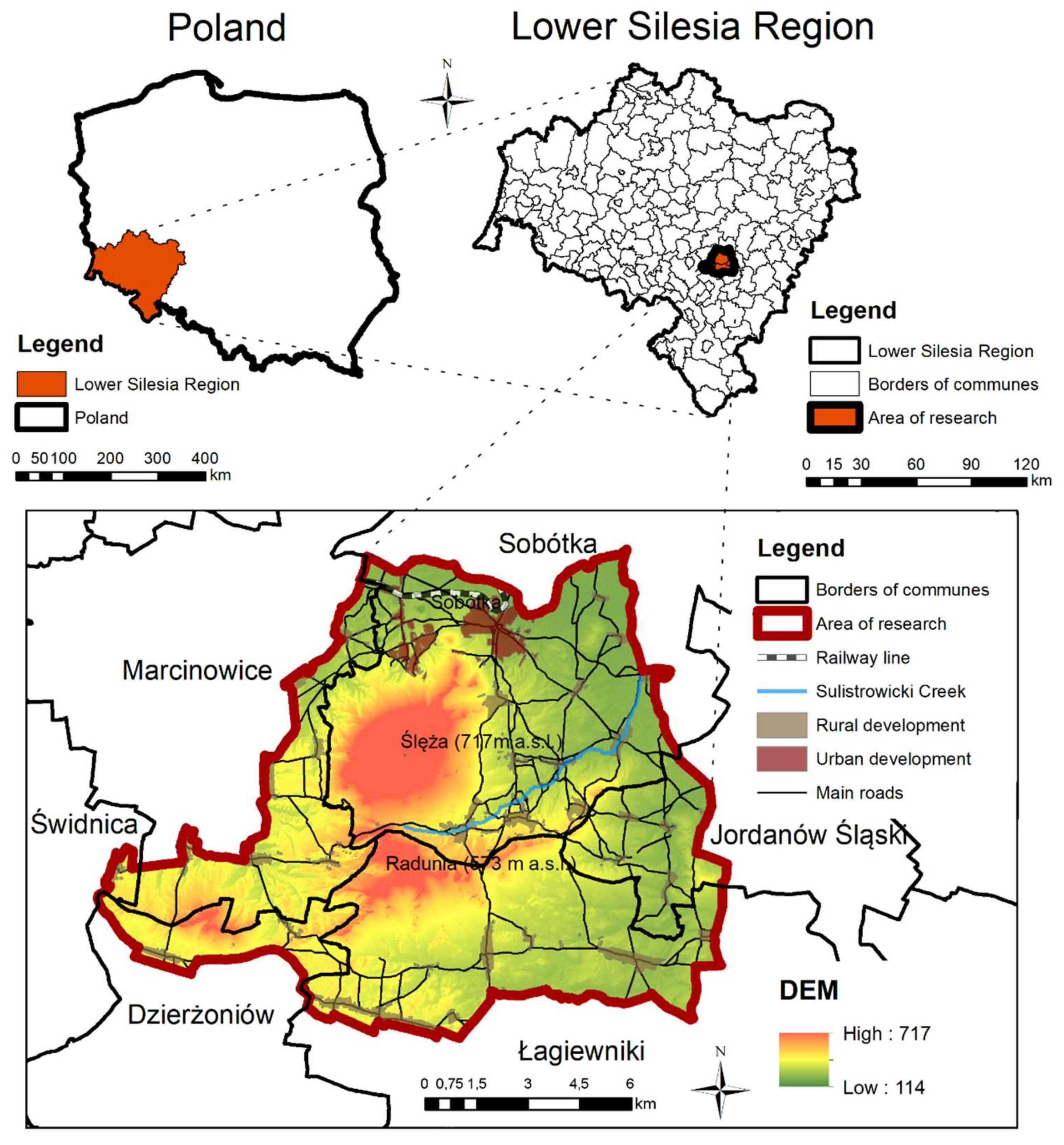

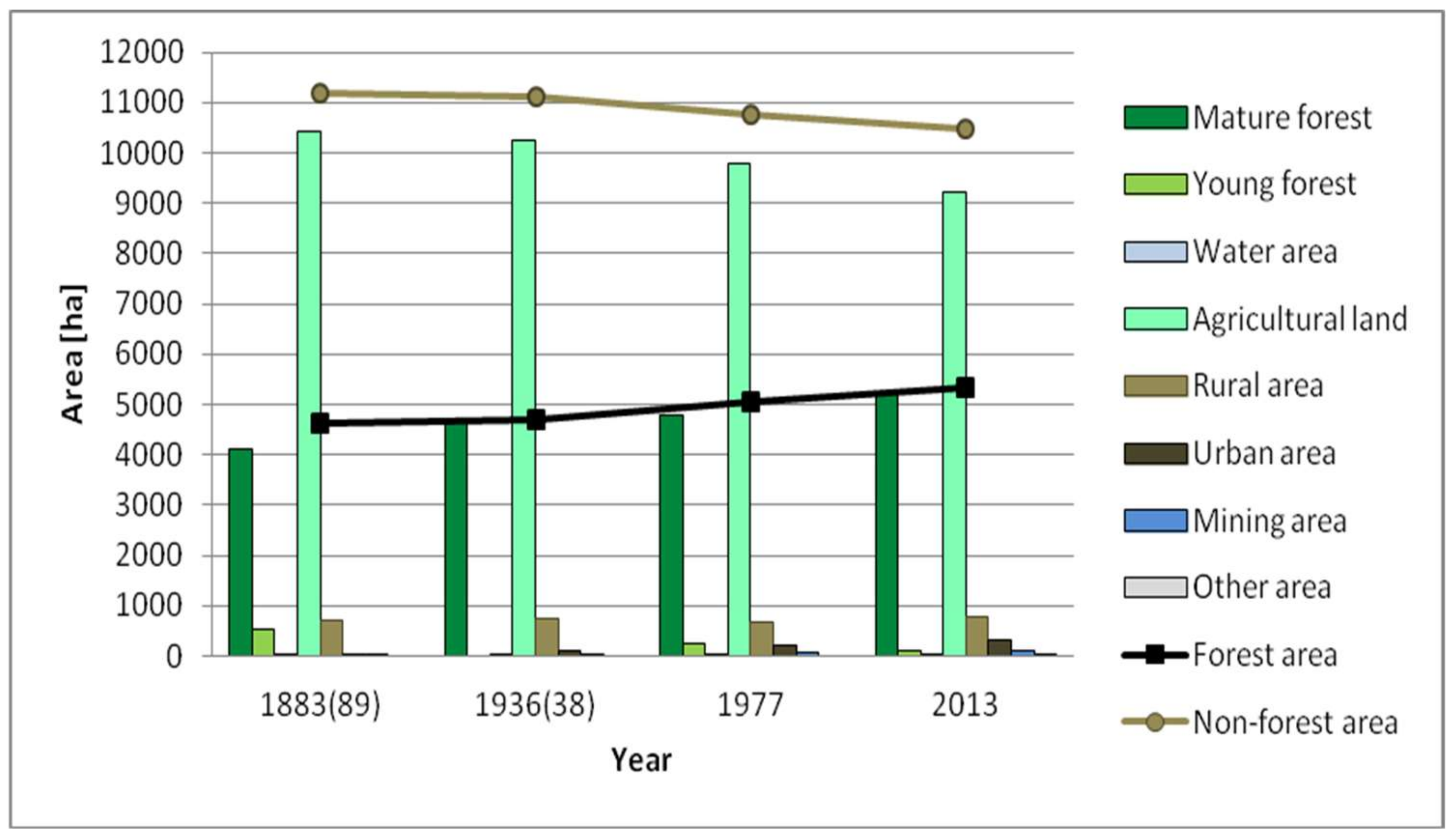
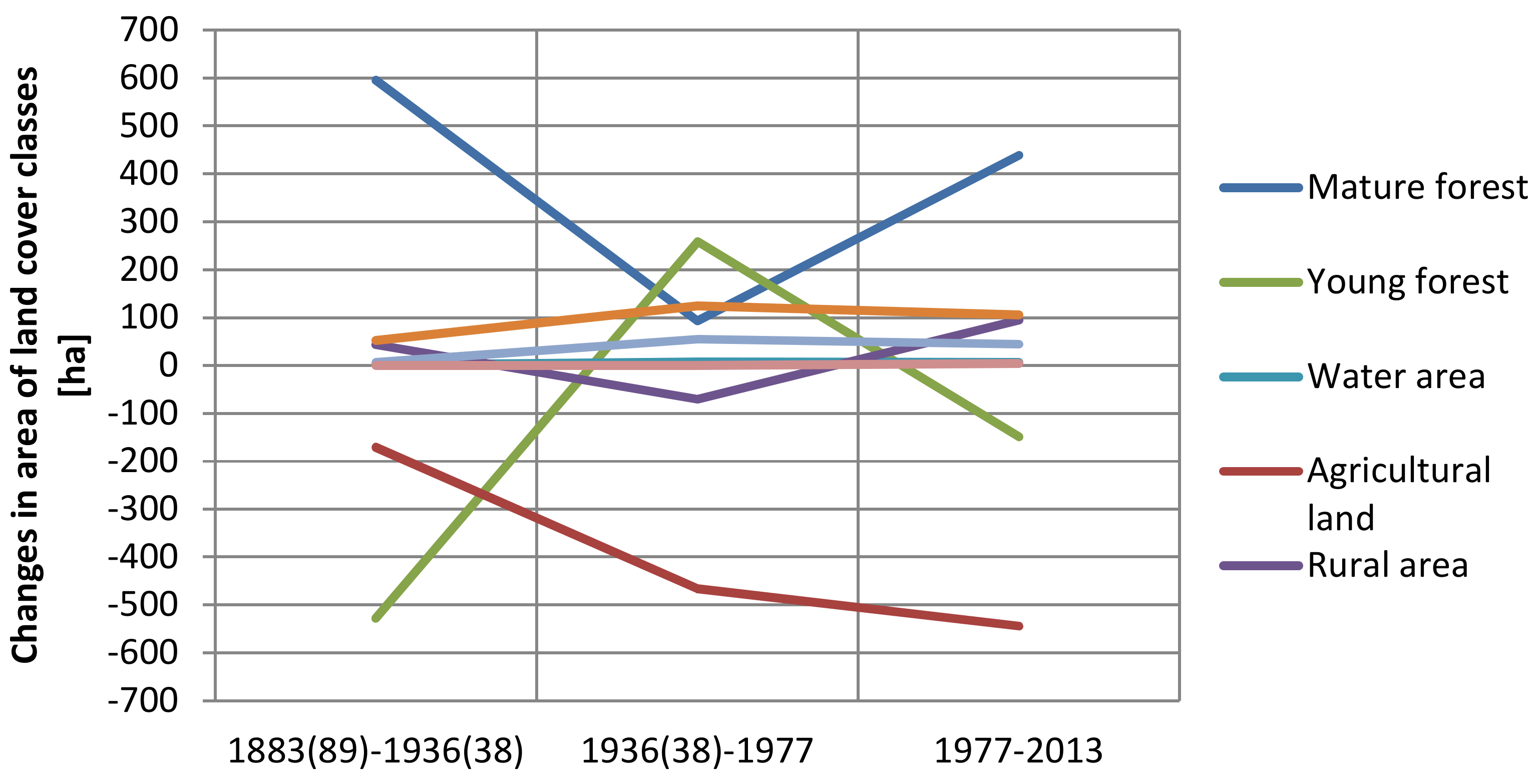
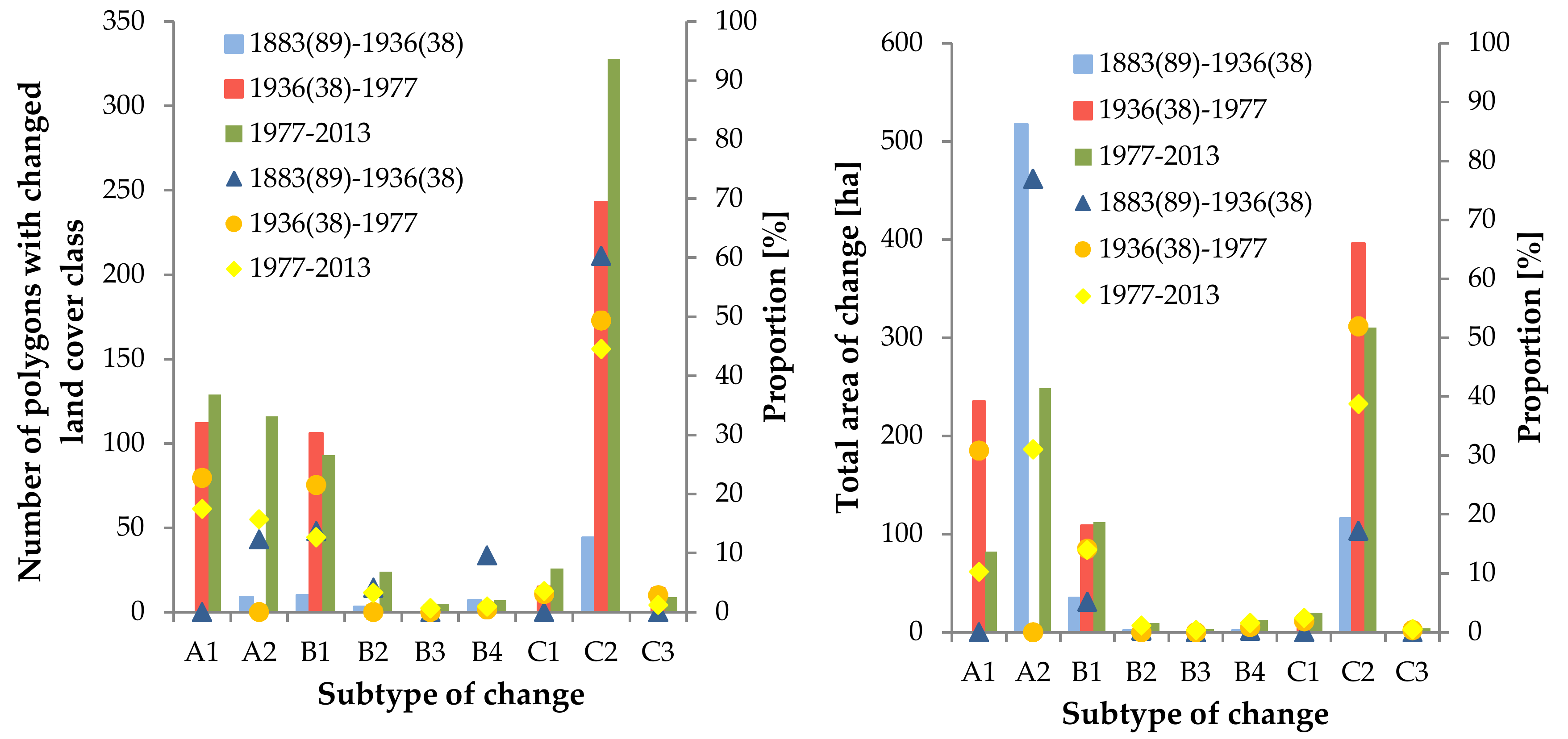
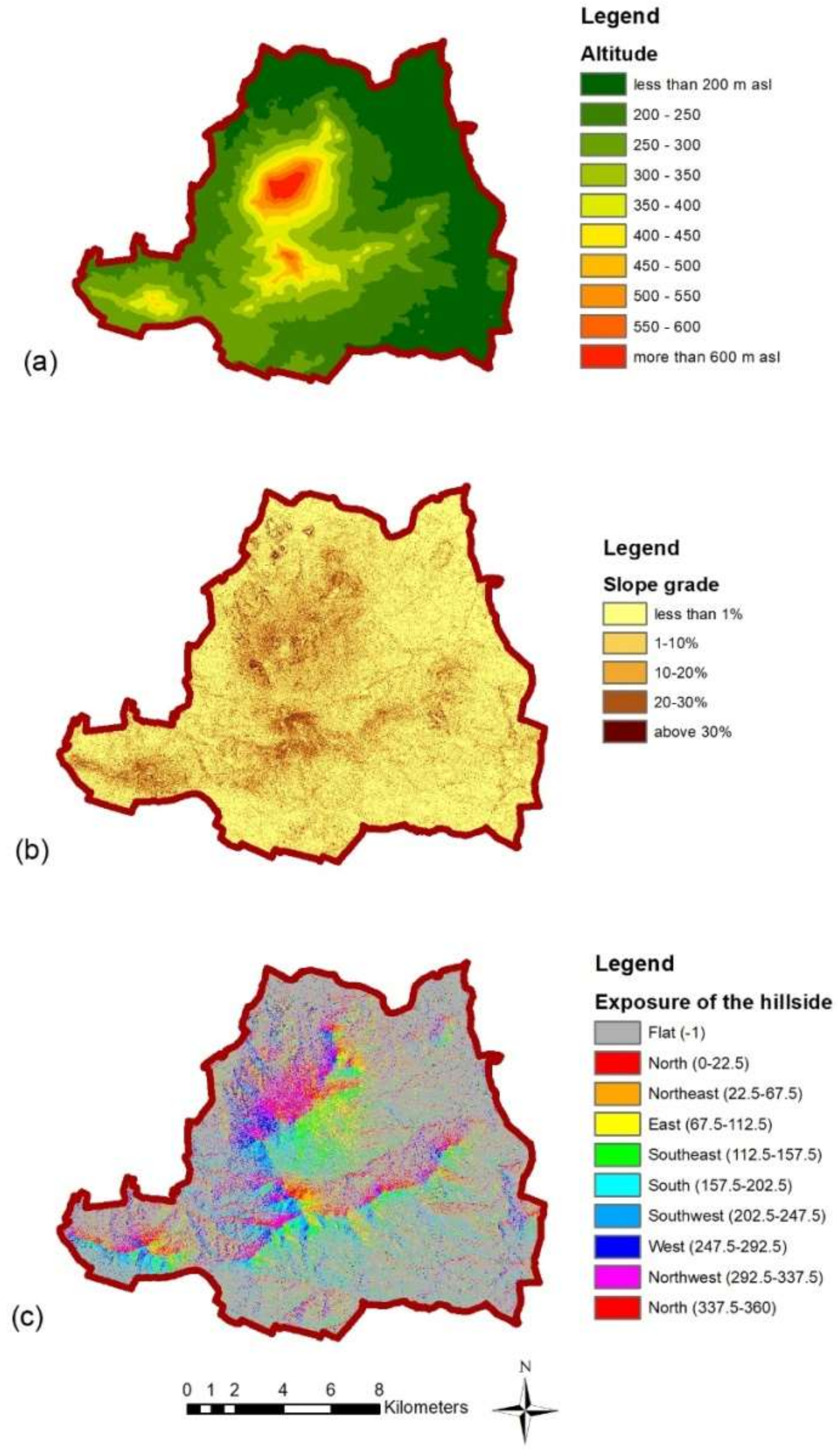
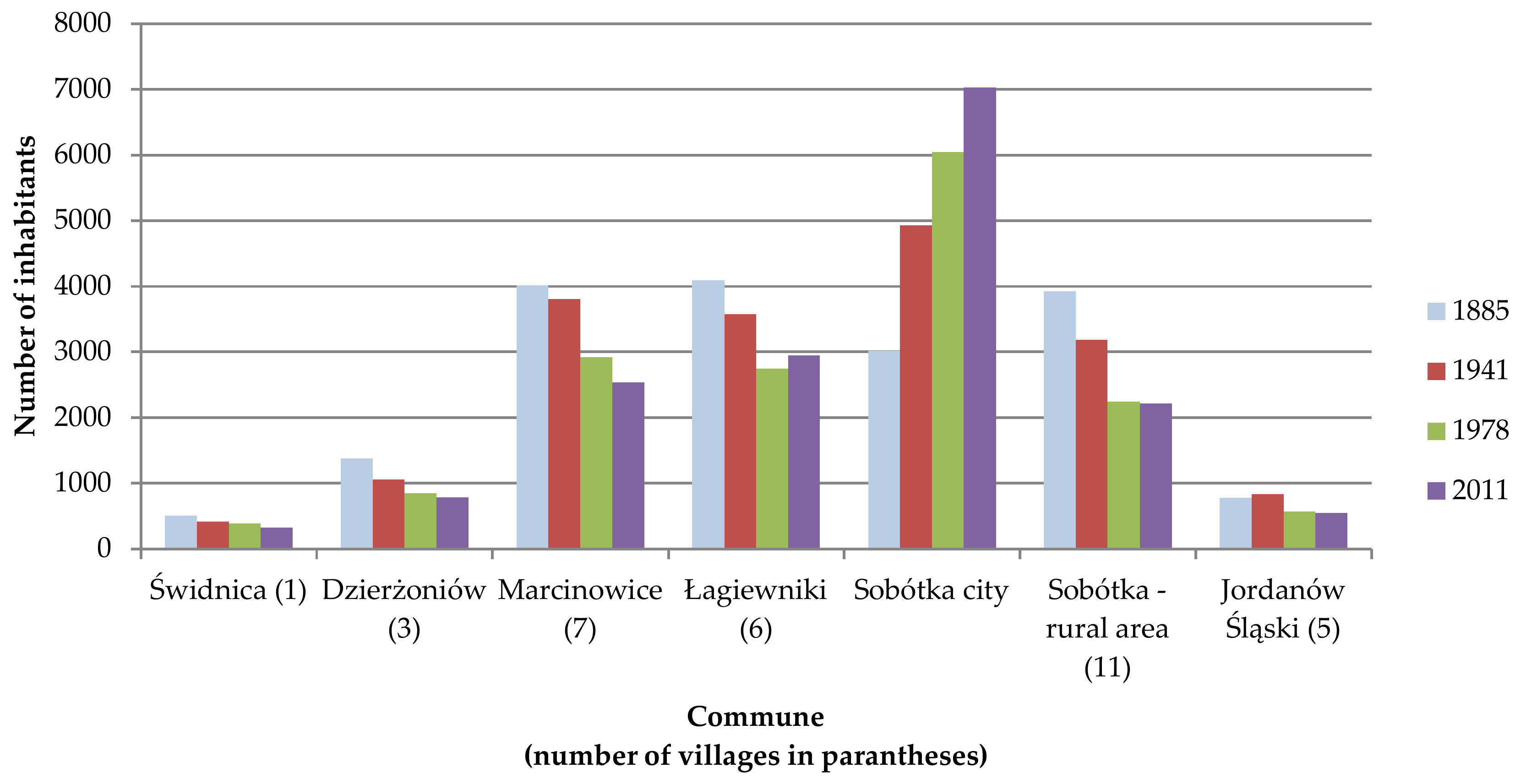
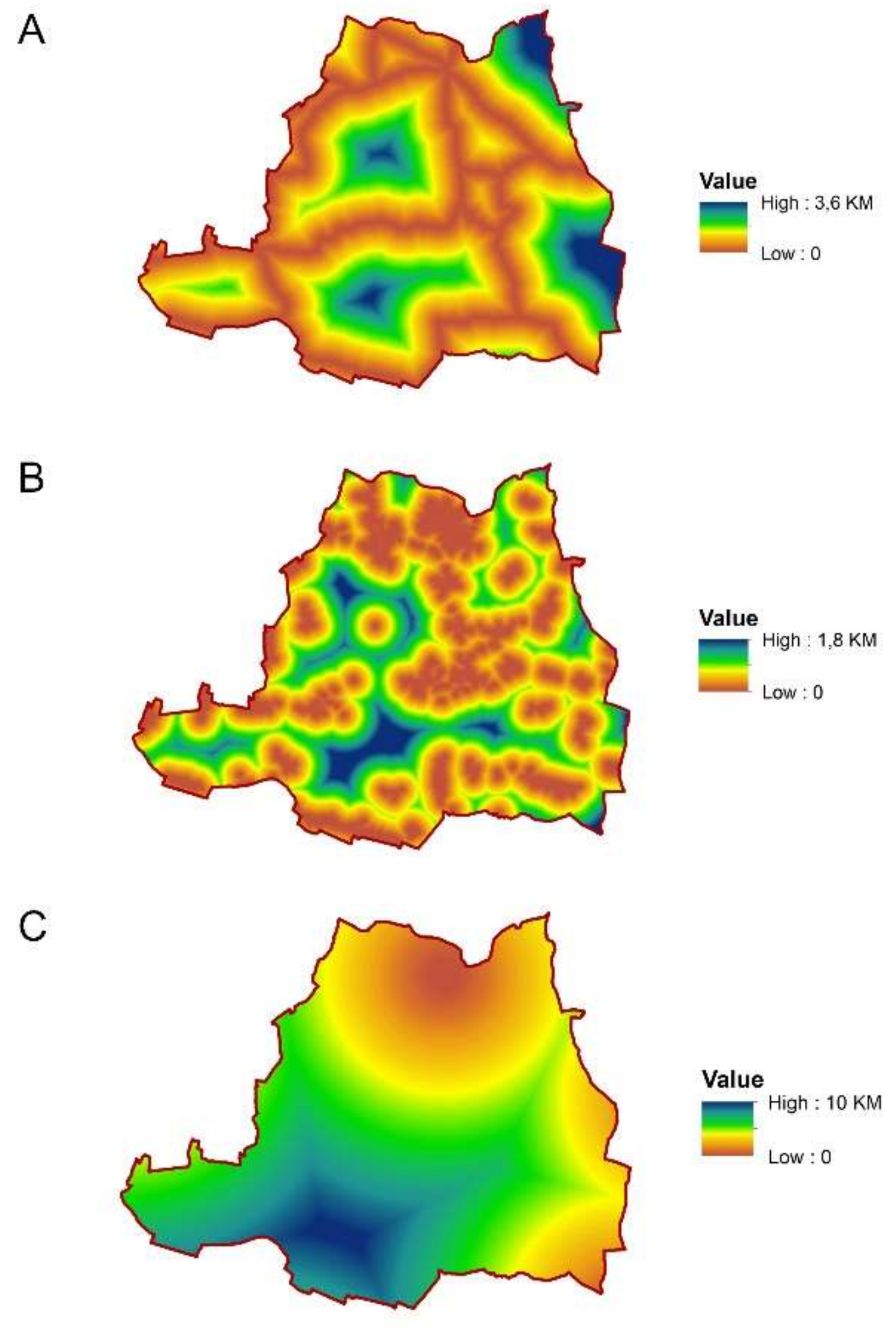
| Map Name | Type of Data | Land Cover Classes | Map Sheets | Date of Release | Source of Data |
|---|---|---|---|---|---|
| Topographische Karte (Messtischblatt) | raster data | forest, plantations and forest nurseries, meadows, pastures, arable land, wetland, marshland, fallow land, water areas, mining areas, urban and rural areas | Zobten Jordansmühl Weizenrodau Lauterbach Mörschelwitz | 1883 1889 1885 1883 1884 | Library of Wroclaw University |
| Topographische Karte (Messtischblatt) | raster data | forest, plantations and forest nurseries (not observed), meadows, pastures, arable land, wetland, marshland, fallow land, water areas, mining areas, urban and rural areas | Zobten am Berge Jordansmühl Weizenrodau Lauterbach Rosenborn | 1938 1938 1936 1936 1937 | Library of Wroclaw University |
| Topographic map of Poland | raster data | mature forest, young forest, bushes, orchards, meadows, arable land, wetland, water areas, mining areas, urban and rural areas | Sobótka, Mysłaków, Dzierżoniów, Jordanów Śląski, Kobierzyce | 1977 | Head Office of Geodesy and Cartography |
| Database of Topographic Objects | vector data | mature forest, young forest, bushes, orchards, meadows, pastures, arable land, wetland, fallow land, water areas, mining areas, landfill, urban and rural areas | Sobótka, Mysłaków, Dzierżoniów, Jordanów Śląski, Kobierzyce | 2013 | Head Office of Geodesy and Cartography |
| Land Cover type | Land Cover Subtype | Description of Class |
|---|---|---|
| Forest area (FA) | Mature forest area (MFA) | Areas covered with forest except young forest areas |
| Young forest area (YFA) | Reforested woodland areas, plantations and forest nurseries | |
| Non-forest area (NFA) | Water area (WA) | Water reservoirs and main watercourses |
| Agricultural land (AL) | Arable land, meadows, pastures, bushes and orchards | |
| Rural development area (RA) | Built-up and recreational areas within all villages | |
| Urban development area (UA) | Built-up and recreational areas in the city of Sobótka | |
| Mining area (MA) | Existing quarries and material storage areas | |
| Other area (OA) | Other unclassified land cover classes, such as wetland, marshland, fallow land, landfills, and forest parking lots |
| Type of Forest Landscape Change | Subtype of Forest Landscape Change | Code of Change |
|---|---|---|
| Transformations within forest landscapes (temporary deforestation, maturation of forest) | Change from a mature forest area into a young forest area (MFA-YFA) | A1 |
| Change from a young forest area into a mature forest (YFA-MFA) | A2 | |
| Transformation from forest landscapes into non-forest landscapes (permanent deforestation) | Change from a mature forest area into agricultural land (MFA-AL) | B1 |
| Change from a mature forest area into a rural development area (MFA-RA) | B2 | |
| Change from a mature forest area into an urban development area (MFA-UA) | B3 | |
| Change from a mature forest area into a mining area (MFA-MA) | B4 | |
| Transformation of non-forest landscapes into forest landscapes (afforestation) | Change from agricultural land into a young forest area (AL-YFA) | C1 |
| Change from agricultural land into a mature forest area (AL-MFA) | C2 | |
| Change from a mining area to a mature forest area (MA-MFA) | C3 |
| Group of Driving Forces | Type of Driving Force | Data Source | Variables Used to Quantify Factors |
|---|---|---|---|
| Natural | Slope grade Hillside exposure Elevation | Map of slope grade from the digital elevation model (DEM) Map of the hillside exposure from the DEM Map of elevation from the DEM | Slope (%) Hillside exposure (Flat, N, NE, E, SE, S, SW, W, NW) Elevation (m a.s.l.) |
| Socioeconomic | Human demographic changes Distance to the main roads Distance to the capital of municipality The distance to the built-up area | Population censuses from 1885, 1941, 1978, and 2011 Land cover maps from four time periods Land cover maps from four time periods Land cover maps from four time periods | Number of inhabitants in each village (pcs.) Distances to national, provincial, and county roads (km) Distance to the center of the capital of the 5 nearest municipalities (km) Distance to the nearest border of built-up area (km) |
| Political | Political events—national and local | Chronicles of events, literature | - |
| Cultural | Cultural events, social changes | Chronicles of events, literature | - |
| Technological | Changes in crop technology and forest management | Chronicles of events, literature | - |
| Time Interval | Indicator | Forest Area | Non-Forest Area | ||||||
|---|---|---|---|---|---|---|---|---|---|
| MFA 1 | YFA 2 | WA 3 | AL 4 | RA 5 | UA 6 | MA 7 | OA 8 | ||
| 1883(89)–1936(38) | CA (%) | 3.77 | –3.34 | 0.01 | –1.08 | 0.28 | 0.33 | 0.04 | 0 |
| LCI | 3.55 | 0.87 | |||||||
| 1936(38)–1977 | CA (%) | 0.59 | 1.63 | 0.04 | –2.95 | –0.45 | 0.79 | 0.35 | 0 |
| LCI | 1.11 | 2.29 | |||||||
| 1977–2013 | CA (%) | 2.78 | –0.94 | 0.04 | –3.44 | 0.60 | 0.67 | 0.28 | 0.02 |
| LCI | 1.86 | 2.53 | |||||||
| Type of Change 1 | Subtype of Change 2 | 1883(89)–1936(38) | 1936(38)–1977 | 1977–2013 | ||||||
|---|---|---|---|---|---|---|---|---|---|---|
| NP (pcs) | AS (ha) | TA (ha) | NP (pcs) | AS (ha) | TA (ha) | NP (pcs) | AS (ha) | TA (ha) | ||
| A | A1 | 0 | 0.0 | 0.0 | 112 | 2.1 | 235.2 | 129 | 0.6 | 82.1 |
| A2 | 9 | 57.5 | 517.7 | 0 | 0 | 0 | 116 | 2.1 | 248.8 | |
| B | B1 | 10 | 3.5 | 34.9 | 106 | 1.0 | 108.4 | 93 | 1.2 | 112.0 |
| B2 | 3 | 0.6 | 1.8 | 0 | 0 | 0 | 24 | 0.4 | 9.2 | |
| B3 | 0 | 0. | 0. | 0 | 0 | 0 | 5 | 0.6 | 3.0 | |
| B4 | 7 | 0.3 | 1.8 | 2 | 3.4 | 6.7 | 7 | 1.8 | 12.3 | |
| C | C1 | 0 | 0 | 0 | 15 | 0.9 | 14.1 | 26 | 0.8 | 19.6 |
| C2 | 44 | 2.6 | 116.0 | 243 | 1.6 | 396.2 | 328 | 0.9 | 310.1 | |
| C3 | 0 | 0 | 0 | 14 | 0.2 | 2.5 | 9 | 0.4 | 3.7 | |
| Total number/area of changes | 73 | - | 672.2 | 492 | - | 763.1 | 737 | - | 800.8 | |
© 2018 by the authors. Licensee MDPI, Basel, Switzerland. This article is an open access article distributed under the terms and conditions of the Creative Commons Attribution (CC BY) license (http://creativecommons.org/licenses/by/4.0/).
Share and Cite
Krajewski, P.; Solecka, I.; Mrozik, K. Forest Landscape Change and Preliminary Study on Its Driving Forces in Ślęża Landscape Park (Southwestern Poland) in 1883–2013. Sustainability 2018, 10, 4526. https://doi.org/10.3390/su10124526
Krajewski P, Solecka I, Mrozik K. Forest Landscape Change and Preliminary Study on Its Driving Forces in Ślęża Landscape Park (Southwestern Poland) in 1883–2013. Sustainability. 2018; 10(12):4526. https://doi.org/10.3390/su10124526
Chicago/Turabian StyleKrajewski, Piotr, Iga Solecka, and Karol Mrozik. 2018. "Forest Landscape Change and Preliminary Study on Its Driving Forces in Ślęża Landscape Park (Southwestern Poland) in 1883–2013" Sustainability 10, no. 12: 4526. https://doi.org/10.3390/su10124526
APA StyleKrajewski, P., Solecka, I., & Mrozik, K. (2018). Forest Landscape Change and Preliminary Study on Its Driving Forces in Ślęża Landscape Park (Southwestern Poland) in 1883–2013. Sustainability, 10(12), 4526. https://doi.org/10.3390/su10124526







